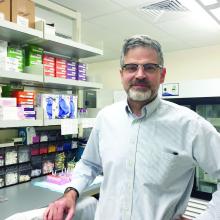Investigators across the United States and Europe hope to answer questions surrounding the feasibility of preventing rheumatoid arthritis in a series of proof-of-concept clinical trials that are enrolling patients with various risk factors for the disease. At least five trials have begun – with one already completed – to prevent RA with disease-modifying antirheumatic drugs, including a U.S. trial with hydroxychloroquine and European trials involving methotrexate, rituximab, and abatacept. Another trial with atorvastatin is also underway.
All of the trials involve participants with different risk factors for RA and may thereby provide a range of answers about where the most promising areas for disease prevention lie.
Hydroxychloroquine
Perhaps the broadest in scope of all the studies investigating the prevention of RA is the StopRA (Strategy to Prevent the Onset of Clinically Apparent Rheumatoid Arthritis) trial, which is randomizing 200 subjects with an anticyclic citrullinated peptide 3 (anti-CCP3) that’s greater than twice the normal level, with or without arthralgia, to either hydroxychloroquine (HCQ) 200-400 mg/day or placebo for 1 year, followed by 2 years of follow-up. Pilot data indicated that a level of 40 U/mL or higher of anti-CCP3, which is twice the normal level for positivity, gave a 50% chance of developing RA in the next 3 years regardless of symptoms, family history, or other factors.
“What we think that does is give us a broader range of people who are in the preclinical period. Because they all won’t have symptoms, they may be even earlier in the progression of their autoimmunity than some of the subjects in other [prevention] studies,” said the trial’s principal investigator Kevin Deane, MD, PhD, a professor of rheumatology at the University of Colorado at Denver, Aurora.The trial’s focus on people with an elevated level of anti-CCP3 limits it to just seropositive individuals, specifically those who are anti-citrullinated protein antibody (ACPA)-positive who constitute about 60%-70% of RA patients with established RA.
The investigators chose to use HCQ because it is a safe and well-tolerated medication for RA, and it may have mechanisms of action that may work particularly well in the early development of RA by blocking inflammation and epitope spreading, Dr. Deane said. “While hydroxychloroquine might not be powerful enough to stop active RA, we hypothesize that it’s just the right drug to block key processes early in its development,” Dr. Deane said in an interview, noting that HCQ is also used to block disease flares in palindromic rheumatism and diminish autoantibody responses in systemic lupus erythematosus.
The StopRA trial is being performed by the Autoimmunity Centers of Excellence, a network sponsored by the National Institutes of Health and the National Institute of Allergy and Infectious Diseases. Enrollment began at 18 U.S. sites in April 2016 with screening of first-degree relatives of patients with RA, community-based screening at health fairs, and finding CCP positive individuals without inflammatory arthritis in rheumatology clinics. The investigators estimate that they will need to screen 20,000 individuals to enroll 200 into the study. Dr. Deane said that he and his coinvestigators hope to use the variables that will arise from the diverse population to later determine subgroups who may respond best to the intervention. “We were concerned that if we made everybody too similar we wouldn’t be able to analyze whether symptoms or other factors mattered or not in who responded to the intervention. It may also allow us to catch some people at an early phase of their autoimmunity and others at a later phase and to determine for future studies when is the best time to intervene in preclinical RA with HCQ.”
It’s possible that HCQ will just delay RA rather than prevent it, Dr. Deane said, perhaps indicating that they may find that HCQ needs to be used longer. In any case, by the time the trial is completed in 2020 the investigators hope to gain rich natural history data to determine how to proceed in future trials, whether they use higher doses, longer-term dosing, or try a different target. In addition, the infrastructure of study sites established in StopRA should be incredibly valuable for future prevention studies.
“I envision a future where everybody is screened for RA risk using good blood tests and then given the opportunity for prevention,” first involving high-risk groups such as family members of people with RA, and then ultimately opening up to population-based screening because 90% of RA occurs in individuals without family history of the disease, Dr. Deane said. An analogy for this might be cardiovascular disease, he said, where we screen the cholesterol level of patients before they have had a heart attack, and if it’s above a certain threshold we prescribe a statin, healthy eating, and exercise in an attempt to prevent cardiovascular events. In the same way, it might be possible to screen people for biomarker risk factors and prescribe a drug and/or a lifestyle change to prevent RA or even prevent many of the other rheumatic diseases including lupus and Sjögren’s syndrome.


